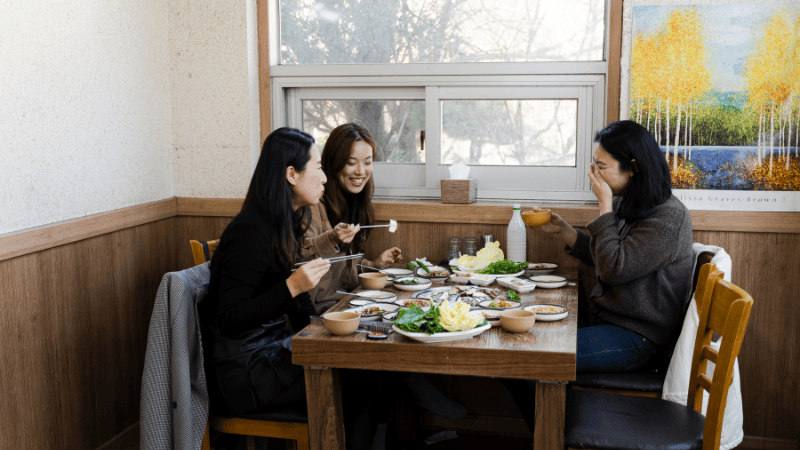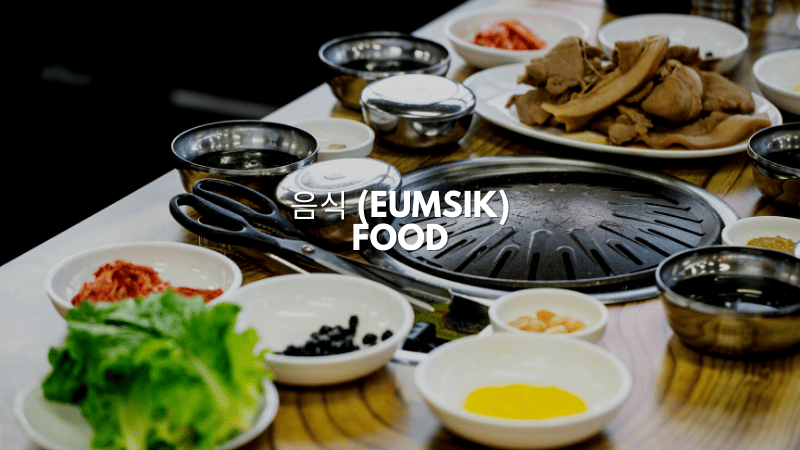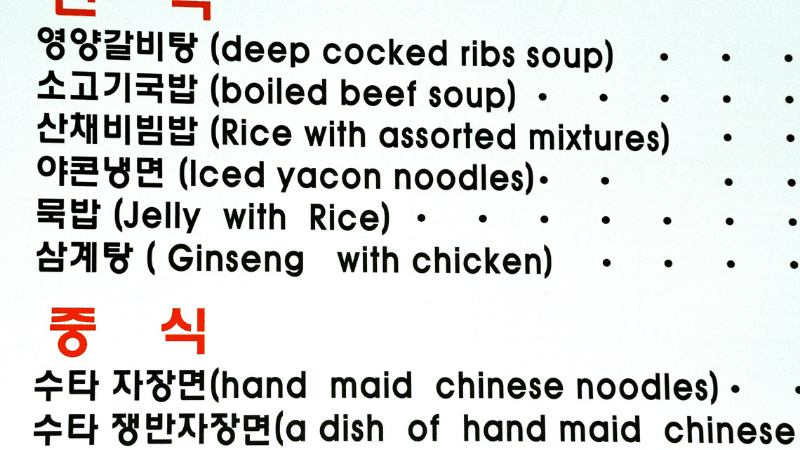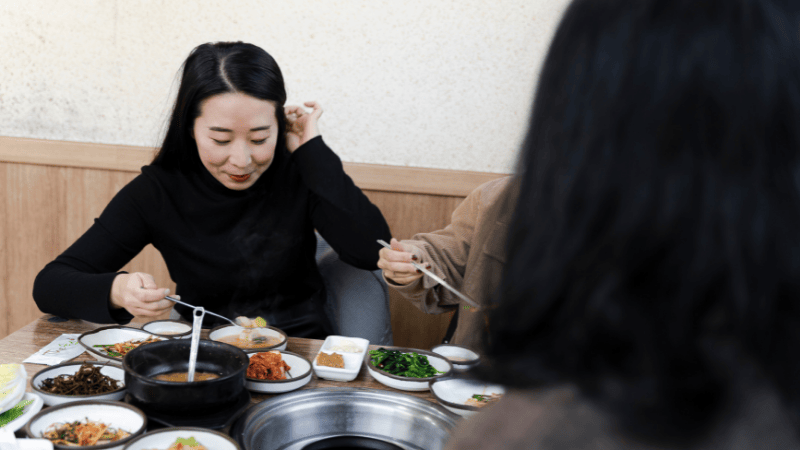Looking forward to eating delicious Korean meals today? Well, before that, you should also learn some essential phrases for ordering food in Korean. Let’s learn more about this in today’s post.
Korean Bbq, Kimchi, Spicy Rice Cakes, Kimchi Stew, and more sumptuous food. These are just a few delicious foods you can eat in a local Korean restaurant. Korean foods are indeed known to different parts of the world. There are a lot of Korean restaurants that you can find in other countries. But, if you want an authentic Korean dining experience, visiting South Korea is a must.
Although most Korean restaurants have an English menu, it’s still friendly and polite to learn Korean phrases for ordering food. But, on top of the superb Korean restaurants and delicious Korean food, there’s something that you should learn first – learning common Korean phrases in ordering food. Learning Korean restaurant phrases will help you have a smooth and unforgettable dining experience.
Dining Etiquette In Korean Culture

Now that you have discovered some traditional Korean food let’s proceed to different dining etiquette. When traveling to South Korea, you should never forget that Koreans value respect and politeness. This is the reason why they have an informal and polite form of speech. Part showing politeness and respect is behaving properly on different occasions. Since we are talking about ordering food in Korean, you should also learn some dining etiquette as a respect for their culture and the people around you.
Oldest Eats First
Koreans follow a certain hierarchy. If you’re from other countries, it might not matter to you who will eat first. But, in South Korea, the oldest person will be the one who will take the first bite, followed by the younger ones. With this, do not be surprised if they ask for your age because it really plays a huge role in their culture. This way, they can interact with you without the fear of offending or disrespecting you.
Say “잘먹겠습니다 (Jalmeokgesseumnida)”
The Korean expression 잘먹겠습니다 (Jalmeokgesseumnida) can be the Korean version of the Japanese expression “itadakimasu.” Saying this before a meal is a way of expressing your gratitude towards the person who prepared the food. Remember, in Korea, being appreciative and polite can go a long way.
Know Your Utensils
Koreans use a set of chopsticks and a spoon when eating. The spoon is for the soups and stews, and the chopsticks are for the rest of the food on the dining table. You can’t use both spoon and chopsticks at the same time. Koreans don’t use their fingers when they are eating. It is also important to know where to put them when not in use. Your utensils shouldn’t be on any dishes on the dining table. Your chopsticks shouldn’t also be stuck on your bowl because they believe it brings bad luck, and it looks like Korean funeral rites.
Learn How To Handle Alcoholic Drinks
Koreans don’t just fill their own glasses when it’s already empty. It is the other person’s responsibility to fill your glass so, don’t fill your own because it will cause the other person to lose face. If an older person invited you for a drink, do not refuse unless you really have an important reason. Also, if you are drinking with an older person, you should always make sure to fill it up as soon as you can. This is considered as common courtesy in Korean culture.
When you are drinking, you should hold the cup with both hands. This also applies when pouring a drink for others. If pouring with both hands is difficult, put your opposite hand under your elbow to help support your pouring arm.
Another interesting thing to learn about Korean drinking etiquette is that when you are drinking with someone older, you should face sideways while drinking. This is also a way to show respect and politeness.
Use The Plates Correctly
In a typical Korean meal, dishes are mostly served on large plates, especially communal dishes, whether at home or in a Korean restaurant. So, use the smaller plates when eating. Do not eat directly from the large plate.
Say Thank You
Saying thank you is one of the best ways to show your politeness towards the person or people who prepared the food. It is more than just being grateful. It also symbolizes that you appreciate the efforts for preparing the meal. You can say “Thank you!” but in South Korea, they usually say “잘먹었습니다 (Jalmeokeosseumnida).” Do not leave the dining table without showing gratitude.
Ordering Food In Korean Restaurants
Traveling to South Korea will never be complete without going to different Korean restaurants to experience an authentic Korean dining experience. But, the whole Korean dining experience will not be completed by just eating Korean dishes and drinking Korean drinks. Once you have entered the restaurant, you should know what to say. You should know how to interact.
In South Korea, many restaurants offer both English and Korean menu. But, to show respect to their culture, it’s still nice to learn some phrases for ordering food in Korean. This way, you’ll get to interact with the restaurant staff effectively. You can also clarify confusions and make special requests to make your dining experience comfortable.
So, here are some essential phrases for ordering food in Korean.

음식 (Eumsik) – Food
The first vocabulary related to ordering food in Korean is 음식 (Eumsik) – Hello or food. Since we are talking about ordering food, I think it’s nice to start by knowing the Korean word for food. This is one of the things we look forward to the most when we are traveling. Food is a fun and exciting way to discover a country’s culture. As stated above, Korean dishes are not just simple dishes. It is part of their culture and history.
Entering A Korean Restaurant

When you walk on the streets of South Korea, you’ll notice that there is a wide range and variety of Korean restaurants. They have open restaurants, and there are also restaurants hidden inside a hanok house. There are also restaurants with self-service machines where you can order your food. But, whatever type of restaurant you’re in, it is still beneficial to learn some phrases and words for ordering food in Korean.
In most restaurants, the staff will greet and assist you as soon as you enter. So, here are some important words to start a conversation and sound polite.
1. 안녕하세요 (Annyeonghaseyo) – Hello
Greetings are still one of the most common ways to start a conversation politely. If you have entered a Korean restaurant, the staff will surely greet you and entertain you. Greeting them back is a way to show respect and politeness. Koreans usually greet with a bow, so you better learn how to do greetings correctly. You may check the blog about common Korean greetings to know more. Remember, politeness can go a long way. These restaurant staff will offer their service and dedication to you, so you might as well return it by being polite and respectful.
2. 빈 자리가 있어요? (Bin Jariga Isseoyo?) – Do You Have Any Free Tables?
The next vocabulary for ordering food in Korean is 빈 자리가 있어요? (Bin Jariga Isseoyo?). If you’re in an open restaurant, it is easy to see if there are free tables, but if you’re in a more formal restaurant, you should ask first if they have free tables. Do not just walk inside and choose whatever table you want. This is also a sign of respect. You can also use your finger to state the number of people who will eat if you still don’t know how to use Korean numbers.
Understanding The Korean Menu

Once you’re already settled, it’s time to choose what to eat. This is the time when you ask for the menu. Here are some essential phrases for ordering food in Korean related to asking for the menu.
3. 메뉴 주세요? (Menyu Juseyo?) – May I Have A Menu, Please?
This is the simplest and most polite way to ask for the menu. Sometimes, the staff is pretty occupied with other tasks, so you might need to get their attention by saying 저기요. (jeogiyo). You can also raise your hand to signal them that you need their help.
4. 영어 메뉴 있어요? (Yeongeo Menyu Isseoyo?) – Do You Have An English Menu?
Most restaurants already have English translations on their Korean menu. But, if the restaurant doesn’t have one, you can ask for their English menu. So, the phrase “영어 메뉴 있어요? (Yeongeo Menyu Isseoyo?)” is a very important phrase for ordering food that you should learn. If they don’t have an English menu, you can look at the pictures because it will give you a glance at the dishes.
5. 추천하시겠습니까? (Chu Cheon Ha Si Gess Seup Ni Kka?) – What Do You Recommend?
Is this your first time trying Korean food, and you don’t have any idea what to order? Don’t worry because you can ask for a recommendation. To do that, you should learn this important vocabulary about ordering food in Korean. By doing this, you’ll know what their best-sellers are. The staff will also say something about the dish and try to see if the ingredients are okay with you.
Ordering Food

After asking for the menu, you’ll have to place your order. Remember, being polite is the key so stay humble and respectful. Eating in South Korea is convenient. There are lots of restaurants, food chains, and food carts. You can also order food to be delivered to your doorstep. Some of the most popular apps for food deliveries are Yogiyo (요기요) and Baedal Minjok (배달의민족). These apps can be easily downloaded on your mobile phone, whether you’re an Android or Apple user. So here is some vocabulary about ordering food in Korean that you must learn.
6. 주문하실래요? (Jumunhasillaeyo?) – Would You Like To Order?
The waiter or the store owner typically asks this vocabulary. When you are asked this question, you can simply reply by saying 네, 주세요 (ne, juseyo) or “Yes, please” in English.
7. 주문할께요. (Jumunhalkkeyo.) – I’d Like To Order, Please.
Another essential vocabulary about ordering food in Korean is 주문할께요. (Umunhalkkeyo.). This is a way of telling the waiter or staff that you are ready to place your order. If you can notice, there is still the word “please” because it’s really important to be respectful and polite.
8. ____ 주세요. (____ Juseyo.) – I’ll Have ____, Please.
This is the easiest and the most common vocabulary you can use in ordering food in Korean. You can simply insert the dish you are ordering in the blank, and you’re good to go. This is a polite way to place your order.
9. 그게 다예요. (Geuge Tayeyo.) – That’s All.
Waiters or staff will usually repeat your order. This is done to make sure that they are taking your order right. If they asked you “다른 것이 있습니까? (daleun geos-i issseubnikka?)” which means “Is there anything else?”, you can say “그게 다예요. (Geuge Dayeyo.)”
Stating Your Requests In The Korean Language

Allergies, religious traditions, culture, self-advocacies, beliefs, and health conditions. These are the common concerns that people face when ordering food. So, here are some important phrases for ordering food in Korean that is related to stating your simple requests.
10. 채식주의자 음식이 있어요? (Chaesikjuuija Eumsigi Isseoyo?) – Do You Have Vegetarian Food?
Let’s say you’re not into meat or you are not allowed to eat; what will you do? – ask if they have food for vegetarian people. There is a large population of Buddhists in South Korea. Because of this, there are also lots of people who are vegetarian. But, it’s not just Buddhist. There are also people who choose to be vegetarian; by asking this, you’ll be able to see if they have food for you. Some chefs will specifically customize the meal for you, but it’s not always this way.
11. 고기는 빼 주세요. (Gogineun Ppae Juseyo.) – No Meat, Please.
In connection with the previous one, you can ask for them to remove the meat for you. This vocabulary for ordering food in Korean can be beneficial for people who don’t eat meat.
12. 맵게 하지 말아J주세요 (Maepge Haji Marajuseyo) – Non-spicy, Please.
Koreans are very fond of spicy dishes. But, if you’re not into spicy food, you can always ask them to reduce or remove the spiciness of a dish. If the dish is really spicy in nature, you might consider ordering another dish.
When The Food Is Served

When the food is being served, there are some expressions that you’ll need to know. Again, in Korean culture, it’s nice to always show your politeness and appreciation to the one who prepared the food. So here is some additional essential vocabulary for ordering food in Korean.
13. 맛있게드세요(Masissge Deuseyo) – Eat Deliciously!
This expression is usually said by the waiter or the one who prepared the food. It is also a way of saying to be comfortable while eating the food. You can always reply by saying “Thank you,” or using the expression below.
14 . 잘 먹겠습니다 (Jal Meokgessseupnida) – I Will Eat Well.
This expression is the most common way to express your gratitude towards the person who prepared your food. This is also a polite expression to say when you are invited for a meal. It is a way of telling that person that you appreciate the food being served.
Paying For The Meal

After a fantastic dining experience, you will now have to proceed with paying for the meal. You can either pay for the meal with cash or a card. There are also some gift cards and coupons that you can use in some restaurants or fast-food chains. So, here are some important vocabulary for ordering food in Korean related to paying for the meal.
15. 계산서 주세요? (Gyesanseo Juseyo?) – Can I Have The Bill, Please?
This is one of the most important vocabulary to learn. If you’re in a restaurant, you’ll be asking for the bill from the staff so you can just simply say 계산서 주세요? (gyesanseo juseyo?). It is a polite way to ask for the bill. You don’t have to worry about the tip in Korea, unlike in other countries. Some restaurants already add a service charge to your bill, so tipping isn’t necessary. But, you’re welcome to do so if you really enjoyed the food and service.
16. 이거 얼마예요? (Igeo Eolmayeyo?) – How Much Is It?
Another politely asking for the 이거 얼마예요? (igeo eolmayeyo?). When you order a meal in a restaurant, they usually hand you the bill on a clipboard. But, if they did not, this is a vocabulary for ordering food in Korean that will help you. It is also a polite way to ask for the total price of what you have ordered.
17. 현금으로 낼 수 있어요? (Hyeongeumeuro Nael Su Isseoyo?) – Can I Pay With Cash?
There are different ways to pay for your meal in Korea. The most common way is paying with cash. To do this, you should have Korean money with you. You can exchange your money in the bank to help you get along in South Korea. You can also use the cash when you want to eat in food carts along the streets.
18. 카드로 낼 수 있어요? (Kadeuro Nael Su Isseoyo?) – Can I Pay By Card?
If you don’t have cash, you can also pay with a card. If you want to pay with a card, you can simply say 카드로 낼 수 있어요? (Kadeuro Nael Su Isseoyo?).
19. 영수증 주세요. (Yeongsujeung Juseyo.) – I’d Like A Receipt, Please.
There will be instances that you’ll be needing your receipt, maybe for company reimbursement or liquidation purposes. This is usually applicable in business meetings. But, if ever you need the receipt, you can say “영수증 주세요. (Yeongsujeung Juseyo.)”
20. 감사합니다 (Gamsahapnida) – Thank You!
The last but definitely one of the most important vocabularies for ordering food in Korean is saying “Thank You.” After an amazing meal and a nice service, it wouldn’t hurt to be nice and show your gratitude towards the restaurant staff. They will also say this as you leave the restaurant, so this is really an important vocabulary to learn.
Other Korean Words And Korean Phrases For Ordering Food
Did you enjoy learning the first 20 vocabularies? Then, here are some more words and phrases for ordering food in Korean.
Want To Speak Korean Like A Native Speaker?

Imagine how amazing it is to speak Korean like a native speaker to your Korean friends. For every Korean fan, being able to speak Korean fluently is an honor. This will be achieved by developing our Korean language skills. So here is something that might help you develop your Korean language skills – Ling App.
Have you ever thought that learning a language can be so fun and meaningful simultaneously? With Ling App, you can learn a language just like you’re playing a game. You can choose from various topics that you can learn with mini-games, quizzes, audio recordings, images, translations, and romanizations. You can also read blog posts like this to help you learn about Korean culture.
There’s so much to discover with Ling App. So, why not start your first lesson with Ling App now? Next time you’ll know you’re already able to speak Korean like a native speaker!
















